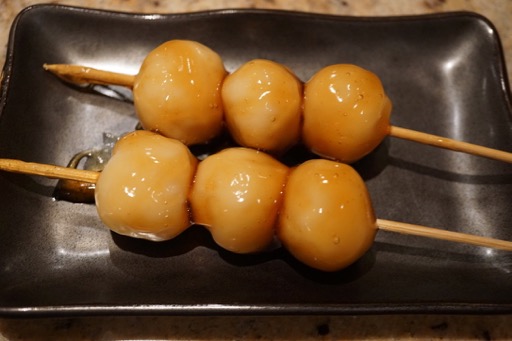Full moon on September 29 (Harvest moon) in Japanese is called “Chuu-shuu-no-meigetsu” 中秋の名月. Traditionally, the Japanese admire (gaze) at the full harvest moon and that “celebration” is called “Tsuki-mi” 月見. Some plants such as pampas grass or “Susuki” ススキ and balloon flower or “
Kikyou” 桔梗 (shown below) are associated with tsuki-mi. As for the food associated with Tuskimi it is usually something spherical in shape i.e. resembling the full moon. The most famous is “
Tsukimi-dango” 月見団子 which I’ve made several times before, using “mochiko” flour and tofu. I made it again this year. The picture below shows the “tuskimi-dango” in front of a “Tenugui” Japanese washcloth depicting “Chuu-shuu-no-meigetsu” and balloon flower. This is the prototypical scene depicting tsukimi. Unfortunately, it was cloudy on the 29th and we could not see the moon. We had to be satisfied with gazing at the full moon on the wash cloth.
It is the tradition for tsukimi to make a pyramid using 15 of the dango (9+4+2) . I made 20 dango. We couldn’t resist and tasted 2 with “Mitarashi sauce”. These type of dango are called “
Mitarashi dango” みたらし団子 which I posted before. Nonetheless despite this early indulgence we still had enough dango to make the appropriate pyramid (shown below).
Just for convenience, I duplicate the recipe we published previously.
Ingredients:
for the Dumpling:
"Mochiko" rice flour 100gram
Sugar 2 tbs (30gram)
Silken tofu about 1/2 (gradually added until right consistency is attained)
for Mitarashi sauce:(all weighed since amounts are rather small).
Soy sauce 40ml (or grams)
Sugar 60 gram
Dashi broth 100ml (or grams)
Mirin 15ml (or grams)
Potato starch 15 gram
Directions:
For Dumpling:
Add the flour and sugar in a bowl (#2).
Add a small amount of the tofu (#3) at times to the dry ingredients and mix by hand.
Add more tofu until the dough forms but is still soft (#4) (The Japanese instructions say "texture of an ear lobe).
Using a small ice cream scoop, make small balls (need to make at least 15, I made 19).
Cooking them in boiling water until they float on the surface and cook additional 3 minutes (#5).
Put cooked dango in ice cold water for few minutes and drain (#6).
The best way to enjoy the dango is “Mitarashi dango” みたらし団子. We microwave the dango and heat up the sauce (I use a small pan, if it gets too watery add more potato starch slurry). Coat the heated dango and just for show, I skewer the three dango together (see below).
This year, I also made “nitsuke” 煮付け or “nikkorogashi” 煮転がし(left in the picture below) using frozen “
Sato-imo” 里芋 taro which we got from Weee. I usually do not use frozen taro but I was curious enough to get it some time ago. It is very interesting that the frozen taro are perfectly spherical. When I was looking through the Japanese cooking site “e-recipe”, one of the dishes they listed for “Tuskimi” was this dish since frozen sato-imo is spherical and an appropriate representation of the moon for Tsukimi’
Although we could not see the full moon on the 29th, we could see the near-full moon on the 27th. Not really a good picture but it was beautiful.
The dango were a real treat. The ones made with rice flour had a very pleasing texture. They were fluffy and soft. The mitarashi coating was a perfect combination of slightly sweet and slightly salty. The taro dango were a nice addition. They were soft but not mushy and perfectly seasoned. What fun.



















